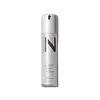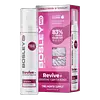What's inside
What's inside
 Key Ingredients
Key Ingredients

 Benefits
Benefits

 Concerns
Concerns

 Ingredients Side-by-side
Ingredients Side-by-side

Water
Skin ConditioningGlycerin
HumectantPanthenol
Skin ConditioningBiotinoyl Tripeptide-1
Myristoyl Pentapeptide-17
Skin ConditioningLactic Acid
BufferingSh-Polypeptide-50
Skin ConditioningKeratin
Skin ConditioningCeramide NP
Skin ConditioningCarbomer
Emulsion StabilisingMaltodextrin
AbsorbentRubus Fruticosus Leaf Extract
MaskingCitric Acid
BufferingSodium Phosphate
BufferingSodium Chloride
MaskingPotassium Sorbate
PreservativeMannitol
HumectantSodium Carbonate
BufferingBenzoic Acid
MaskingPhosphatidylcholine
EmulsifyingSodium Benzoate
MaskingDecyl Glucoside
CleansingHydrolyzed Sodium Hyaluronate
Skin ConditioningXanthan Gum
EmulsifyingSodium Hyaluronate
HumectantIsopropyl Cloprostenate
Cetyl Alcohol
EmollientSodium Hydroxide
BufferingPhenoxyethanol
PreservativeWater, Glycerin, Panthenol, Biotinoyl Tripeptide-1, Myristoyl Pentapeptide-17, Lactic Acid, Sh-Polypeptide-50, Keratin, Ceramide NP, Carbomer, Maltodextrin, Rubus Fruticosus Leaf Extract, Citric Acid, Sodium Phosphate, Sodium Chloride, Potassium Sorbate, Mannitol, Sodium Carbonate, Benzoic Acid, Phosphatidylcholine, Sodium Benzoate, Decyl Glucoside, Hydrolyzed Sodium Hyaluronate, Xanthan Gum, Sodium Hyaluronate, Isopropyl Cloprostenate, Cetyl Alcohol, Sodium Hydroxide, Phenoxyethanol
Water
Skin ConditioningIsobutane
Trimethoxycaprylylsilane
SmoothingOleth-100
Cetyl Alcohol
EmollientCetearyl Alcohol
EmollientTerminalia Chebula Extract
AstringentBiotin
AntiseborrhoeicAsparagus Racemosus Root Powder
Skin ConditioningSodium Hyaluronate
HumectantFolic Acid
Skin ConditioningSorbitan Fatty Acid Ester
EmulsifyingDecyl Glucoside
CleansingPvm/Ma Decadiene Crosspolymer
Myristyl Alcohol
EmollientStearyl Alcohol
EmollientEthylhexylglycerin
Skin ConditioningGlycerin
HumectantSodium Hydroxide
BufferingLeuconostoc/Radish Root Ferment Filtrate
AntimicrobialPhenoxyethanol
PreservativeWater, Isobutane, Trimethoxycaprylylsilane, Oleth-100, Cetyl Alcohol, Cetearyl Alcohol, Terminalia Chebula Extract, Biotin, Asparagus Racemosus Root Powder, Sodium Hyaluronate, Folic Acid, Sorbitan Fatty Acid Ester, Decyl Glucoside, Pvm/Ma Decadiene Crosspolymer, Myristyl Alcohol, Stearyl Alcohol, Ethylhexylglycerin, Glycerin, Sodium Hydroxide, Leuconostoc/Radish Root Ferment Filtrate, Phenoxyethanol
Alternatives
Ingredients Explained
These ingredients are found in both products.
Ingredients higher up in an ingredient list are typically present in a larger amount.
Cetyl Alcohol is a fatty alcohol. Fatty Alcohols are most often used as an emollient or to thicken a product.
Its main roles are:
Though it has "alcohol" in the name, it is not related to denatured alcohol or ethyl alcohol.
The FDA allows products labeled "alcohol-free" to have fatty alcohols.
Learn more about Cetyl AlcoholDecyl Glucoside is a glucose-based surfactant and emulsion stabilizer. It is created by reacting glucose with the fatty acids from plants.
Surfactants help clean the skin by trapping oil, sebum, and dirt to be washed away. As an emulsion stabilizer, it stabilizes the ingredients in a product by preventing them from separating.
This ingredient is biodegradable and non-toxic. This ingredient is commonly found in baby shampoos.
Decyl Glucoside is sometimes used to stabilize the UV filter Tinosorb.
Learn more about Decyl GlucosideGlycerin is already naturally found in your skin. It helps moisturize and protect your skin.
A study from 2016 found glycerin to be more effective as a humectant than AHAs and hyaluronic acid.
As a humectant, it helps the skin stay hydrated by pulling moisture to your skin. The low molecular weight of glycerin allows it to pull moisture into the deeper layers of your skin.
Hydrated skin improves your skin barrier; Your skin barrier helps protect against irritants and bacteria.
Glycerin has also been found to have antimicrobial and antiviral properties. Due to these properties, glycerin is often used in wound and burn treatments.
In cosmetics, glycerin is usually derived from plants such as soybean or palm. However, it can also be sourced from animals, such as tallow or animal fat.
This ingredient is organic, colorless, odorless, and non-toxic.
Glycerin is the name for this ingredient in American English. British English uses Glycerol/Glycerine.
Learn more about GlycerinPhenoxyethanol is a preservative that has germicide, antimicrobial, and aromatic properties. Studies show that phenoxyethanol can prevent microbial growth. By itself, it has a scent that is similar to that of a rose.
It's often used in formulations along with Caprylyl Glycol to preserve the shelf life of products.
Sodium Hyaluronate is hyaluronic acid's salt form. It is commonly derived from the sodium salt of hyaluronic acid.
Like hyaluronic acid, it is great at holding water and acts as a humectant. This makes it a great skin hydrating ingredient.
Sodium Hyaluronate is naturally occurring in our bodies and is mostly found in eye fluid and joints.
These are some other common types of Hyaluronic Acid:
Learn more about Sodium HyaluronateSodium Hydroxide is also known as lye or caustic soda. It is used to adjust the pH of products; many ingredients require a specific pH to be effective.
In small amounts, sodium hydroxide is considered safe to use. However, large amounts may cause chemical burns due to its high alkaline.
Your skin has a natural pH and acid mantle. This acid mantle helps prevent harmful bacteria from breaking through. The acid mantle also helps keep your skin hydrated.
"Alkaline" refers to a high pH level. A low pH level would be considered acidic.
Learn more about Sodium HydroxideWater. It's the most common cosmetic ingredient of all. You'll usually see it at the top of ingredient lists, meaning that it makes up the largest part of the product.
So why is it so popular? Water most often acts as a solvent - this means that it helps dissolve other ingredients into the formulation.
You'll also recognize water as that liquid we all need to stay alive. If you see this, drink a glass of water. Stay hydrated!
Learn more about Water